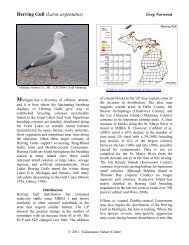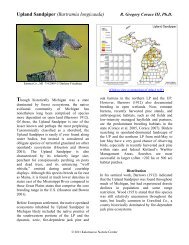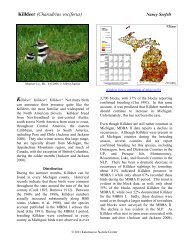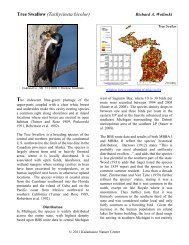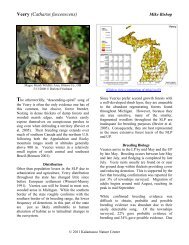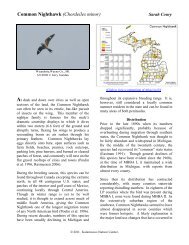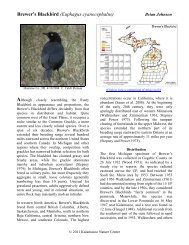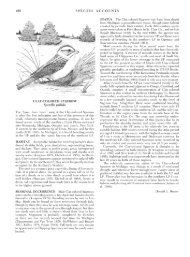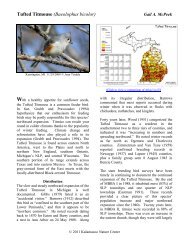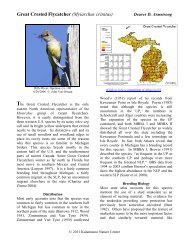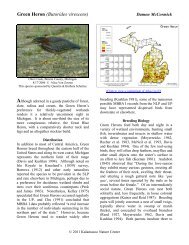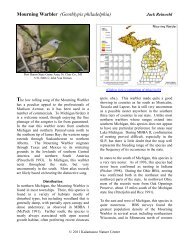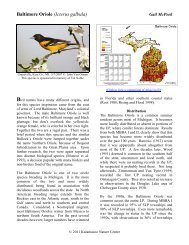Brown Thrasher - Michigan Breeding Bird Atlas Website
Brown Thrasher - Michigan Breeding Bird Atlas Website
Brown Thrasher - Michigan Breeding Bird Atlas Website
Create successful ePaper yourself
Turn your PDF publications into a flip-book with our unique Google optimized e-Paper software.
<strong>Brown</strong> <strong>Thrasher</strong> (Toxostoma rufum)<br />
Raymond J. Adams, Jr.<br />
Manistee Co., MI. 6/21/2009 © Darlene Friedman<br />
This species sponsored by<br />
the Audubon Society of Kalamazoo<br />
(Click to view a comparison of <strong>Atlas</strong> I to II)<br />
Anyone familiar with the <strong>Brown</strong> <strong>Thrasher</strong><br />
during the breeding season is well aware of its<br />
pugnacity. This colorful mimid presents a fierce<br />
demeanor when threatened by potential nest<br />
predators, as I learned at an early age. The<br />
<strong>Brown</strong> <strong>Thrasher</strong> readily throws itself at humans,<br />
dogs, snakes and other birds (pers. obs.). This<br />
thrasher is easily identified as few species are<br />
similar in appearance. There are a handful of<br />
thrushes with comparable patterns, but all lack<br />
the long graceful tail and yellow eye. The only<br />
species which might cause confusion is the<br />
similar Long-billed <strong>Thrasher</strong> which overlaps<br />
with the <strong>Brown</strong> <strong>Thrasher</strong> in south Texas. The<br />
<strong>Brown</strong> <strong>Thrasher</strong> breeds from the East Coast to<br />
the Rocky Mountains and from the Canadian<br />
Prairie Provinces and the south edge of the<br />
boreal forest to the Gulf Coast. In winter it<br />
retires to the southern third of the United States<br />
with a few birds overwintering each year into<br />
the northern U.S. This species breeds<br />
throughout <strong>Michigan</strong>, although it is less<br />
common in the Upper Peninsula and rare on Isle<br />
Royale.<br />
Distribution<br />
On careful examination of the <strong>Michigan</strong> atlas<br />
map for the <strong>Brown</strong> <strong>Thrasher</strong>, this species is<br />
widespread in the LP, reported from 73% of the<br />
townships with a near universal distribution in<br />
the southwestern counties. The prevalence of<br />
thrashers in southwestern <strong>Michigan</strong> is<br />
associated with their preference for deciduousmixed<br />
shrub upland, shrubby old field, and<br />
shrub wetland (Eastman 1991). In addition, this<br />
area of the state has extensive farmland<br />
bordered by hedgerows and tree-lined<br />
fencerows, which provide alternative nesting<br />
cover. Elsewhere in the LP, the <strong>Brown</strong><br />
<strong>Thrasher</strong> is fairly uniform in distribution. In the<br />
eastern third of the LP from Lenawee and<br />
Monroe counties all the way to the Straits of<br />
Mackinac, there is a north/south corridor where<br />
this species is sometimes absent. The causes for<br />
these gaps in occurrence are not obvious from<br />
looking at a map. During MBBA I, the <strong>Brown</strong><br />
<strong>Thrasher</strong> was present in every township in<br />
Oakland and Livingston counties. In MBBA II,<br />
this species was unrecorded in 21 townships in<br />
these same two counties. Urbanization, human<br />
population increases, and the accompanying loss<br />
of habitat likely explain losses of <strong>Brown</strong><br />
<strong>Thrasher</strong> in these two counties (and effort<br />
decreased there from 1,739 hours in MBBA I to<br />
901 hours in MBBA II). But distribution gaps<br />
away from large population centers are more<br />
difficult to explain.<br />
© 2011 Kalamazoo Nature Center
<strong>Brown</strong> <strong>Thrasher</strong> (Toxostoma rufum)<br />
In the Upper Peninsula, the <strong>Brown</strong> <strong>Thrasher</strong> was<br />
recorded in 270 blocks and 221 townships in<br />
MBBA I, but only 228 blocks and 186<br />
townships in MBBA II. The overall distribution<br />
in the UP in MBBA II has changed little from<br />
the previous survey. This bird is widely<br />
distributed north of Wisconsin, especially in<br />
Menominee, Dickinson, Marquette and Iron<br />
counties. Elsewhere in the UP, the distribution<br />
is clumped with large regions where the species<br />
is apparently absent, presumably because the<br />
“earlier shrub stages of plant succession” they<br />
require are missing (Eastman, 1991).<br />
<strong>Breeding</strong> Biology<br />
The adage “timing is everything” is certainly<br />
relevant when surveying for the <strong>Brown</strong><br />
<strong>Thrasher</strong>. Males typically return before<br />
females, by mid April or earlier in the SLP<br />
(Bent 1948), to establish territory. On arrival,<br />
they may counter sing with other males in close<br />
proximity. Singing continues from the tallest<br />
available perch to attract females as they begin<br />
to arrive. The song period is not long in<br />
duration (Cavitt and Haas 2000), but at this time<br />
the species is easy to locate, especially when<br />
multiple males are present. Interestingly, males<br />
sing less frequently when competition is lacking<br />
(pers. obs.). <strong>Brown</strong> <strong>Thrasher</strong>s renew singing<br />
prior to the second brood or following an initial<br />
nest failure. Once nesting starts the male helps<br />
incubate and feed the young (Cavitt and Haas<br />
2000) and the <strong>Brown</strong> <strong>Thrasher</strong> becomes much<br />
less conspicuous. It is not until the young<br />
fledge and begin following the adults around for<br />
food that the thrasher again is more easily<br />
located. Clutch size ranges from 2 to 6 eggs and<br />
may vary seasonally and regionally.<br />
Abundance and Population Trends<br />
(Click to view trends from the BBS)<br />
The <strong>Brown</strong> <strong>Thrasher</strong> was likely present in<br />
<strong>Michigan</strong> well before the time of European<br />
settlement. It was present when Sager published<br />
the first state bird list in 1839 and was listed by<br />
each of the authors throughout the rest of the<br />
Raymond J. Adams, Jr.<br />
19 th and 20 th centuries. It undoubtedly<br />
benefitted from the increase in human<br />
settlement and lumbering as suggested by<br />
Gibbs’ report that it “breeds in all half-cleared<br />
localities in LP” (1879). Most of the comments<br />
regarding abundance are vague. Whether you<br />
read Barrows (1912), who said “summer<br />
resident of all parts of the state…most abundant<br />
in the southern half” or Payne (1983) who<br />
described it as “common in the Lower<br />
Peninsula, more local and less common in the<br />
Upper Peninsula”, exactly how common was it<br />
It probably reached its peak abundance in the<br />
late 1800s following forest clearing. There is<br />
little data on actual numbers in <strong>Michigan</strong> during<br />
the early 20 th century, but in Illinois the <strong>Brown</strong><br />
<strong>Thrasher</strong> declined 74% from 1909 through 1958<br />
(Cavitt and Haas 2000). With the increased use<br />
of pesticides following World War II, there is<br />
every reason to expect that trend continued.<br />
Federal BBS routes from 1966 through 2007<br />
indicate a decline of more than 80% of <strong>Brown</strong><br />
<strong>Thrasher</strong> numbers in <strong>Michigan</strong> (Sauer et al.<br />
2008), while Kalamazoo County BBS surveys<br />
suggest an 86% drop from 1970 through 2006.<br />
<strong>Michigan</strong> <strong>Breeding</strong> <strong>Bird</strong> <strong>Atlas</strong> data from 1983-<br />
2008 also indicate a decline. During MBBA I,<br />
there were nearly 4,100 pairs found in over<br />
2,500 blocks, while the MBBA II results total<br />
about 3,500 pairs in 1,845 blocks. Clearly, the<br />
<strong>Brown</strong> <strong>Thrasher</strong> is on a downward trend.<br />
Conservation Needs<br />
While the <strong>Brown</strong> <strong>Thrasher</strong> is neither threatened<br />
nor endangered, the rapid population decline<br />
over the past 50 to 100 years is cause for alarm.<br />
As with other declining species which occupy<br />
similar habitat or rely on similar food, a number<br />
of hypotheses have been proposed for the<br />
causes. Following the expansion of pesticide<br />
use after World War II, the <strong>Brown</strong> <strong>Thrasher</strong><br />
suffered increased visible mortality as well as<br />
indirect mortality in and around agricultural<br />
operations (Cavitt and Haas 2000). This no<br />
doubt continues today. Collisions are known to<br />
© 2011 Kalamazoo Nature Center
<strong>Brown</strong> <strong>Thrasher</strong> (Toxostoma rufum)<br />
be another serious mortality factor. While<br />
stationary objects such as towers and windows<br />
are well known obstacles, automobiles and<br />
trucks cause heavy mortality. During <strong>Atlas</strong><br />
surveys in southwestern <strong>Michigan</strong>, <strong>Brown</strong><br />
<strong>Thrasher</strong> road kills including young were noted<br />
on occasion (pers. obs.). Because this bird is a<br />
short distance migrant, it is less likely to be<br />
exposed to severe weather in migration. Harsh<br />
winters in the south have been known to cause<br />
major impacts. Habitat degradation and loss<br />
may be the greatest problem of all.<br />
Habitat protection may be the most important<br />
management opportunity. Efforts could include<br />
protecting hedgerows, letting fields go fallow,<br />
providing brush cover along agricultural field<br />
edges, and designing housing developments<br />
where portions of the natural areas are salvaged.<br />
Because roadside mortality has become an<br />
issue, finding ways to alter roadsides so that<br />
wildlife is provided greater protection would<br />
help many bird species, not just the <strong>Brown</strong><br />
<strong>Thrasher</strong>. All children deserve the chance to<br />
discover the <strong>Brown</strong> <strong>Thrasher</strong>’s defensive<br />
behaviors for themselves.<br />
Literature Cited<br />
Barrows, W.B. 1912. <strong>Michigan</strong> bird life.<br />
Special Bulletin. <strong>Michigan</strong> Agricultural<br />
College, East Lansing, <strong>Michigan</strong>, USA.<br />
Bent, A.C. 1948. Life Histories of North<br />
American Nuthatches, Wrens, <strong>Thrasher</strong>s,<br />
and Their Allies. U.S. National Museum<br />
Bulletin 195.<br />
Cavitt, J.F., and C.A. Haas. 2000. <strong>Brown</strong><br />
<strong>Thrasher</strong> (Toxostoma rufum). Account 557<br />
in A. Poole and F. Gill, editors. The <strong>Bird</strong>s<br />
of North America. The <strong>Bird</strong>s of North<br />
America, Inc., Philadelphia, Pennsylvania,<br />
USA.<br />
Eastman, J. 1991. <strong>Brown</strong> <strong>Thrasher</strong> (Toxostoma<br />
rufum). Pages 364-365 in R. Brewer, G.A.<br />
McPeek, and R.J. Adams, Jr. The <strong>Atlas</strong> of<br />
<strong>Breeding</strong> <strong>Bird</strong>s of <strong>Michigan</strong>. <strong>Michigan</strong><br />
Raymond J. Adams, Jr.<br />
State University Press, East Lansing,<br />
<strong>Michigan</strong>, USA.<br />
Gibbs, M. 1879. Annotated list of the birds of<br />
<strong>Michigan</strong>. Bulletin of the US Geological<br />
and Geographical Survey of the Territories<br />
5:481-497.<br />
Payne, R.B. 1983. A Distributional Checklist<br />
of the <strong>Bird</strong>s of <strong>Michigan</strong>. Miscellaneous<br />
Publication 164. University of <strong>Michigan</strong><br />
Museum of Zoology, Ann Arbor, <strong>Michigan</strong>,<br />
USA.<br />
Sager, A. 1839. Report of Doctor Abraham<br />
Sager, zoologist of Geological Survey.<br />
House Documents of the State of <strong>Michigan</strong>:<br />
410-421.<br />
Sauer, J.R., J.E. Hines, and J. Fallon. 2008.<br />
The North American <strong>Breeding</strong> <strong>Bird</strong> Survey,<br />
Results and Analysis 1966-2007. Version<br />
5.15.2008. USGS Patuxent Wildlife<br />
Research Center, Laurel, Maryland, USA.<br />
Suggested Citation<br />
Adams, R.J., Jr. 2011. <strong>Brown</strong> <strong>Thrasher</strong><br />
(Toxostoma rufum). In A.T. Chartier, J.J.<br />
Baldy, and J.M. Brenneman, editors. The<br />
Second <strong>Michigan</strong> <strong>Breeding</strong> <strong>Bird</strong> <strong>Atlas</strong>.<br />
Kalamazoo Nature Center, Kalamazoo,<br />
<strong>Michigan</strong>, USA. Accessed online at:<br />
.<br />
© 2011 Kalamazoo Nature Center



